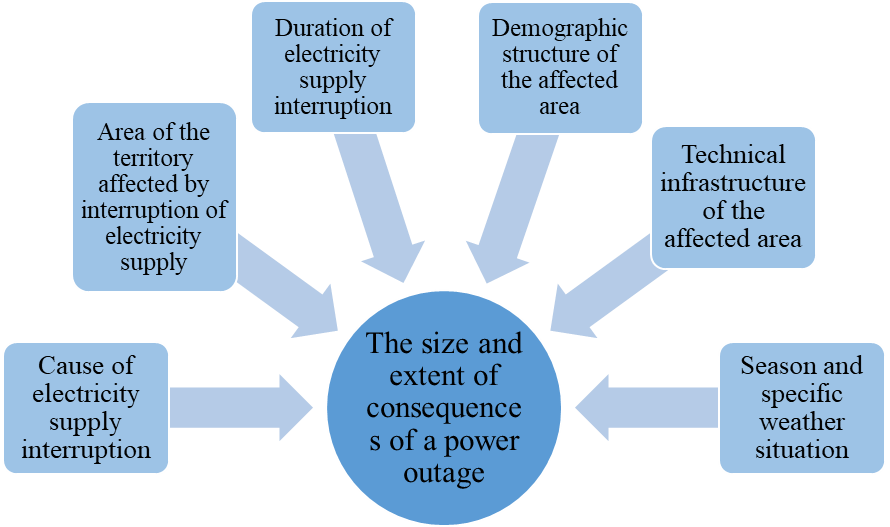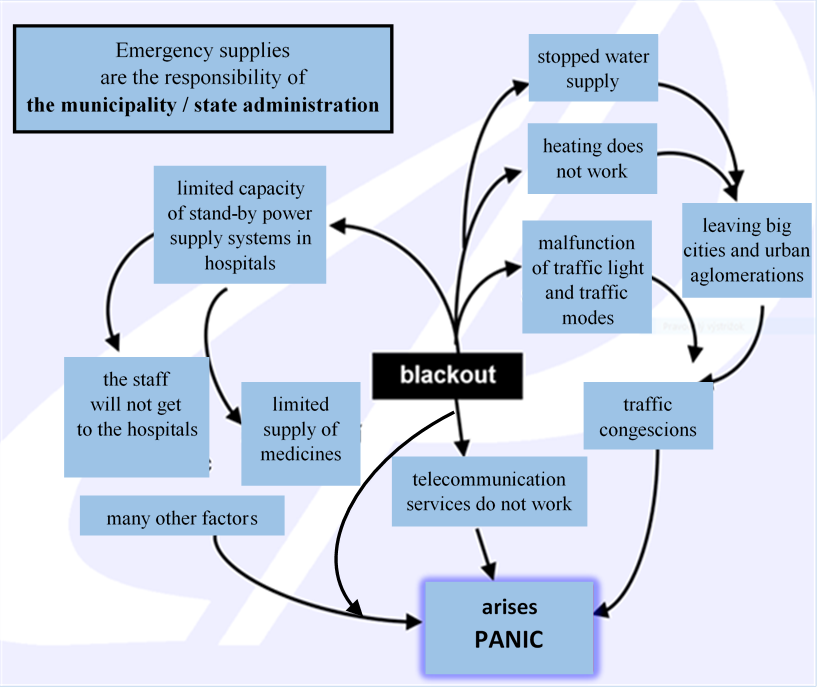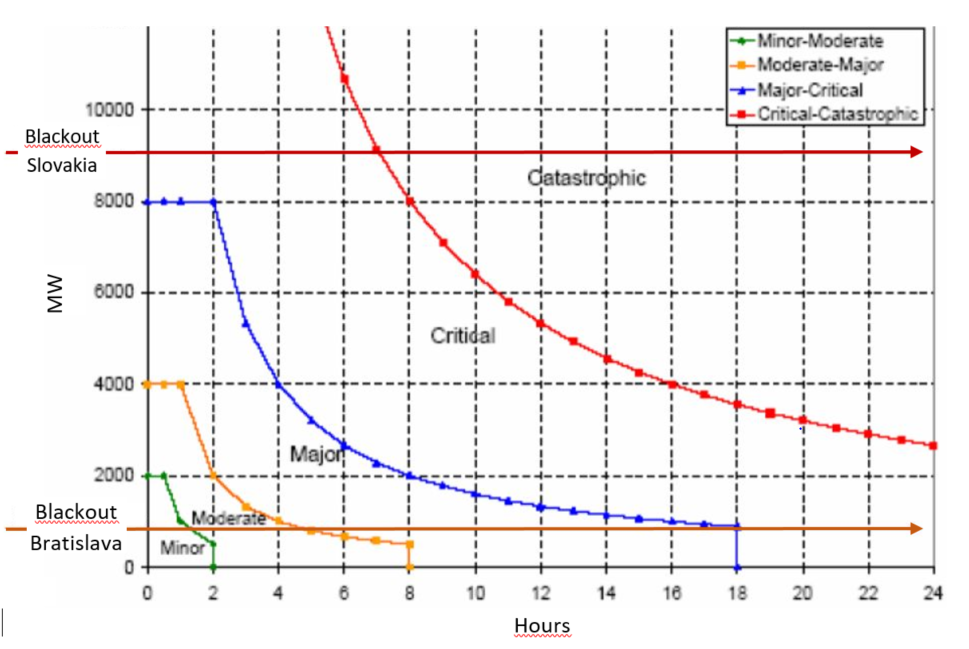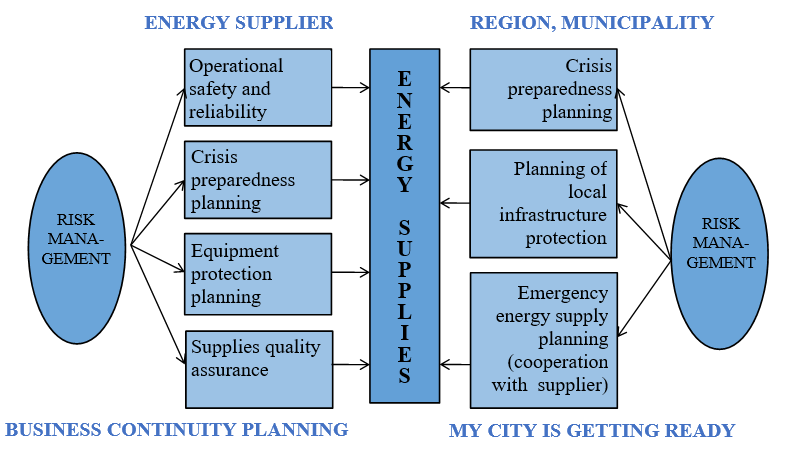INTRODUCTION
Modern society and sustainable technological progress are increasingly dependent on a continuous and reliable supply of electricity. Electricity supply is key to the basic needs and functioning of human society. If the supply of electricity is interrupted or significantly reduced, there is a risk of a reduction in economic and social activities, a threat to property, but often also to human health and life. The electricity sector is of irreplaceable strategic importance in every society and, as it is necessary for the safe and reliable operation of other vital infrastructure, it is included among the key sectors of critical infrastructure. Critical infrastructure is an asset, system or part thereof that is necessary to maintain the basic functions of society, health, protection, security, quality of life of the population from an economic and social point of view, and whose disruption or destruction would have serious consequences for not being able to maintain these functions[1]. A specific feature of the electricity infrastructure is the fact that in the event of its disruption and subsequent interruption of electricity supply, the impacts on the external environment of the electricity system may be much higher and more unfavorable than the equipment damage itself or losses from loss of revenue for undelivered energy. This fact is reinforced by the interconnections and correlations of the electricity sector with other sectors of critical infrastructure, as well as other sectors. Electricity systems in Europe form a complex system and possible disruption or damage to interconnected energy networks can affect a large number of people, endanger their health and lives, cause an adverse environmental impact and cascade effect of the interconnected systems.
CAUSES OF LARGE-SCALE ELECTRICITY SUPPLY DISRUPTION
Disruption of large-scale electricity supply occurs in the case of a significant and sudden shortage of electricity or endangering the integrity of the electricity system, its security and the reliability of operation throughout the country, the defined territory or part of it[2]. If the whole electricity system or a significant part of it finds itself without voltage, there is a negative event called blackout. On a practical level, blackout represents a large-scale disruption of electricity supply to a large number of customers over a period of time. European legislation according to EU Regulation 2017/1485 defines blackout as the state of the electricity system when all or part of the transmission system is out of operation. A blackout failure occurs if at least one of the following criteria is met: 1.) loss of more than 50 % of demand in the concerned Transmission System Operator’s control area, 2.) total absence of voltage for at least three minutes in the concerned Transmission System Operator’s control area, leading to the triggering of restoration plans[3]. The primary causes of disruption of large-scale electricity supply are failures of any of the subsystems of the electricity infrastructure, which consist of: energy sources (power plants), transmission and distribution systems, controller information and control systems, Power plants may be out of operation mainly due to[2]: direct damage to certain manufacturing equipment (due to technical failure, material error, neglect of maintenance, natural disaster, intentional attack,…), malfunction of the control system, improper controller action or manipulation (failure of a human factor), disintegration of the electricity grid supplied by the power plant, lack of fuel or other operating materials. Transmission and distribution systems are particularly vulnerable to[2]: direct damage to a certain line element, malfunction of the control system or the automatic protections, improper controller action or incorrect handling, malfunction of technology, damage, failure of human factor, an imbalance between supply and demand in the system exceeding a certain threshold etc. Controller information and control systems are forced to interrupt their function due to[2]: direct damage to certain elements of the system, incorrect function of system elements – data distortion, incorrect data evaluation, deficiencies in SW equipment, etc., failure of the human factor, intentional overloading of the system, external attack – cyber attack and many others. The transmission system of the Slovak Republic is dimensioned so that it is able to handle the failure of any one critical element, so that a simple failure is relatively easily eliminated. Thus, a large outage of the volume of transmitted electricity due to the collapse of the power system usually occurs with the synergy of several causes, acting at the same time. A frequent cause of cascading power outages is natural factors, such as strong storms, extreme winds, landslides, icing on power lines, forest fires, etc. A significant threat to the electricity system is also the human factor – intentional/unintentional activity resulting in a negative event, as well as wrong decisions in the operating the system. In the conditions of the Slovak Republic, outages in the supply of electricity occur rather sporadically, especially during storms, snow calamities, floods or accidents on the transmission system or during its local overload. However, it can be argued that many serious outages were prevented mainly due to the robust and well-dimensioned transmission system.
IMPACTS OF LARGE-SCALE ELECTRICITY SUPPLY DISRUPTIONS ON SOCIETY
If various preventive or operational interventions fail to prevent the interruption of electricity supply, a failure occurs. Critical infrastructure entities that necessarily need electricity for operation are usually equipped with spare sources (generators, backup sources, etc.). However, back-up electricity sources will be kept in operation by critical infrastructure operators for only a few hours. The situation becomes critical if there is a long-term outage. The magnitude and extent of the effect and impacts of the power outage in the affected area depend on several basic factors[4], as shown in Figure 1. Disruption of large-scale electricity supply causes the emergence and development of a crisis situation – a state of emergency – not only among consumers, but also a threat to the protected interests of the state. The effects of blackout on the critical infrastructure sectors and other sectors of the economy may be as follows: Industry – termination of operations in industrial enterprises can cause serious paralysis of the national economy with significant economic losses.
Gas industry – interruption of natural gas transmission and distribution due to a malfunction of technical equipment dependent on electricity. Oil and petroleum products – malfunction of pumping equipment, termination of oil transportation and production of petroleum products, limited fuel stocks. Communication and information systems – total failure of all ICT systems depending on the size of the capacity of stand-by power supply system. Transport – malfunction of traffic lights and electrical interlocking devices, malfunction of petrol stations, standing electric traction vehicles, standing underground metro system, significantly limited railway transport, stopped air traffic[5]. Water and atmosphere – malfunction of drinking water treatment equipment, malfunction of pumps, paralyzed function of releasing water from tanks, regulation of water flow in rivers, wastewater treatment and sewerage, non-functional meteorological service. Healthcare – only basic outpatient care will be provided by general practitioners without the possibility of using any devices dependent on electricity (diagnostic devices), limited operation of hospitals and hospital facilities, limited capacity of stand-by power supply systems, termination of production of medicines and medical supplies, etc. Public administration – a significant reduction of most functions, e.g. payment of social benefits and pensions, possible problems in prisons, in the judiciary. Crisis departments of state administration and self-government should be prepared for a full function in the given conditions[6]. Banking and financial sector – impossibility to make payments, cash points malfunction. Post – malfunction of technical devices dependent on electricity, e.g. sorting facilities, termination of postal services. Food and agriculture – lack of some foods e.g. due to non-functional mills, bakeries, slaughterhouses, meat and poultry processing plants, reduced milk production, termination of ventilation systems in large farms, termination of refrigeration and freezing equipment. Emergency survival of the population – includes measures for emergency supplies and emergency accommodation. Emergency supplies will focus on the supply of minimum meals, minimum doses of drinking water and the provision of other basic needs to persons affected by an emergency, e.g. heat supply and basic health care[7]. The effects of the long-term blackout on individual sectors of the economy so far have serious social and economic consequences which vary considerably depending on whether they take place in large cities and urban agglomerations or in rural settlements. Compared to urban settlements, rural settlements are able to ensure a certain energy and food self-sufficiency and survive for a certain period of time with the basic needs provided. In contrast, large urban agglomerations have a specific structure and a higher complexity of institutional and functional links, which make their inhabitants highly vulnerable to power outages. The key factors that make large cities and agglomerations more vulnerable include, in particular, the high concentration of population and the interconnected system of urban critical infrastructure, the disruption of which can cause e.g. lack of water, food, heat and thus cause a widespread state of emergency and later also social unrest destabilizing the standard functioning of institutions and the lives of people in big cities.VULNERABILITY OF LARGE CITIES IN THE EVENT OF A BLACKOUT FAILURE
The electricity system of the Slovak Republic ranks among the internal systems due to its location in the European energy infrastructure. It is an electrically compact unit connected via the so-called cross – border lines (400 kV and 220 kV) to the electricity systems of most neighboring countries (Poland – 2, The Czech Republic – 5, Hungary – 2, Ukraine – 1)[8]. The basic strategy of system recovery after a blackout failure is also based on this fact – voltage recovery from neighboring transmission systems. This option is preferred by transmission system operators mainly for the purpose of regaining a stable voltage of the order of minutes. If such a possibility is not available, the control centre of the transmission system proceeds according to the standards for ensuring the restoration of power supply from small backup power plants capable of so-called start from darkness. From the point of view of the topology of the electricity network, the “open-all” strategy is most often used. This means that all switches in the affected area are turned off either automatically or manually. By switching them off, a state is reached in which the controller bases the system renewal solution on clearly defined input conditions. The controller then solves the restart of the power plant units and their continuous loading by gradually connecting other elements of the transmission system. The following priorities are usually respected: 1.) own consumption of nuclear power plants, 2.) own consumption of system conventional power plants, 3.) capital or the most important city of the affected area, 4.) other urban and industrial agglomerations, 5.) other consumers. Renewal of the operation of the distribution system is possible only after the renewal of the operability of the transmission system (or its parts). The distribution system operator is responsible for restoring the power supply to the distribution system. The standard of renewal of electricity distribution after its interruption is to ensure the renewal of supplies to the offtake or handover point of the local distribution system operator within the time limits up to: 18 hours in the distribution system network with a voltage level up to 1 kV, 12 hours in the distribution system networks with a voltage level above 1 kV[9]. Any power outage (even a short-term one) is registered almost immediately by all persons in the affected area. Such a negative event will have more serious effects in areas with a higher concentration of inhabitants, such as large cities or industrial agglomerations. It is in such densely populated agglomerations that the unavailability of basic services and important operational systems and services with time causes a state of panic and chaotic behaviour and decision-making (Fig. 2).
In the event of a blackout failure, it will not be possible to use almost any technology that is directly dependent on the electricity supply and is not simultaneously backed up by alternative energy sources (e.g. diesel generators, batteries, backup UPSs, etc.). In the first phase of the outage (in the order of seconds, minutes) the following will not work: all devices that need to be connected to the electricity nttwork for their operation, ordinary lighting (in households, public buildings, street lamps, ...), security devices for buildings (electric opening of doors, garage doors, etc.), traffic signaling devices (traffic lights, signaling at railway crossings, variable traffic signs, etc.), cashpoint machines and at the same time it will not be possible to make purchases in stores with electronic sales records (barcode scanning, card payments, etc.), most petrol stations, public transport, which is directly dependent on electricity supplies (trains, metro, trams, trolleybuses and others). In the second phase of the outage (in the order of units of hours) problems will arise in areas such as: drinking water supply, gas and heat supply, signal failures of mobile operators, malfunction of data networks (Internet), data centers, etc., waste collection and much more. In the later stages (order of tens of hours) there will be other serious problems in the area: supplies (food, medicines, fuels, etc.), communications (limited access to verified information), functioning of individual offices and other institutions, security (violation of public order, looting, theft, etc.). In connection with the failure of electricity supply, there will be e.g. people get stuck: in lifts (if they are not equipped with special backup sources), in public transport (especially trainsets on electrified lines), in traffic jams (due to a malfunction of traffic signaling devices). Other significant impacts of blackout on the operation of the system include: restrictions on the availability of information, congestion of telephone networks (it will be very difficult to establish contact with close persons), overload of emergency lines and unavailability of units of the Integrated Rescue System, limited operation of hospitals (performed only urgent operations, etc.), limited possibilities to ensure hygienic standards (non-functioning water and waste, perishable food, etc.), limited possibility to buy food and water, limited purchase of fuel, limited possibilities in providing heating, increased risk of fires (emergency lighting with candles, etc.), impossibility of employment and school attendance (most buildings and production facilities will be closed), limited possibility of transport (limited use of public transport, lack of fuel in motor vehicles, etc.) The limit of the standard of renewal of electricity supply to end consumers (within 18 hours) also corresponds relatively well with the results of EU foreign research projects within the PASR call – Preparatory Action on Security Research[10] After about 18 hours, the situation changes from serious to critical (Fig. 3). In case of a national blackout, with a typical daily load (not the maximum) of the Slovak electricity system at the level of approximately 9 000 MW, the situation according to Fig. 3 could become catastrophic after about 7 hours after blackout. In terms of the reliability of the entire electricity supply chain, the risk management system often addresses the question of where it is appropriate to invest in proactive preventive measures (system backup, island solutions,...) to reduce risk and where it is sufficient to leave mitigation only to the implementation of reactive activities that respond to the occurrence of a crisis event. The interoperability of crisis management (supplier and municipality) with the risk management process[11] in the area of supply of vital commodities (apart from electricity, also heat, drinking water, natural gas and others) also plays a role in this decision (Fig.4) Within the recovery plans of transmission or distribution system, in practice it is impossible to predict how a potential outage will develop or predict a point of disruption. A blackout is usually the last phase of a complex event and the result of a series of several events that is almost impossible to define in advance. The process of recovery of the electricity system is generally based on 3 principles: ensuring the ability to “start from the dark” on selected generators (the ability of the power source to go into operation in a situation where the distribution network has lost voltage – in most cases provided by diesel generators), voltage recovery in the transmission system using available generators (heating plants, back-up power plants, etc.) or from neighbouring transmission networks, including resynchronization of individual island operations (island operation = part of the electricity system that operates locally and is not connected to the synchronously operating electricity system), gradual restoration of power supply in distribution systems and restoration of electricity supply to other customers. At present, the most preferred preventive and proactive measure against the negative effects of large-scale blackout in large cities is the implementation of the so-called public crisis island operations (CIO) which enable the implementation of emergency electricity supply. The recovery would take place in smaller parts. Relatively small “energy islands” would be created for the supply and distribution of electricity around some power plants or towns, which would be gradually interconnected[12]. Local urban crisis island networks, usually supplied by municipal heating plants, can play an important role in emergency situations in order to safeguard the protected interests of the state or large and important agglomerations. Sources of the distribution system, which are additionally equipped with the so-called black start, in addition to island operation for emergency power supply, can also be used to restore the operation of the electricity system after the blackout, mainly to start and ensure the own consumption of some system power plants. Such a solution should certainly belong to the basic functionality of currently developed and tested intelligent energy networks – the so-called Smart Grids[13, 14]. It is recommended to increase the energy security of large cities according to[12]: build control systems and interconnections ensuring island power supply of all agglomerations with more than 50 000 inhabitants, implement effective tools to prevent the spread of faults and a controlled transition to island subsystems and ensure an independent ability to start from the dark of individual island solutions, in the area of development of distribution systems, to ensure their ability to work in island operations in the medium term in the event of a breakdown of the transmission network and to ensure at least the minimum level of electricity supply required for the population and critical infrastructure, ensure the elaboration / updating of territorial energy concepts of self-governing units and large cities (over 50 thousand inhabitants) so that they are aimed at ensuring the functionality and reliability of island operations in emergency situations create conditions for the involvement of heating plants in the creation of territorial concepts and the determination of their role in island solutions of a specific area in emergency situations. link the content of measures to increase the preparedness and resilience of energy infrastructures of large cities with the content of economic measures for crisis situations[15, pay attention to the preparation of alternative variants of the functioning of energy systems so as to ensure at least the most necessary energy supplies to priority customers, support the construction of stand-by power supply of electricity, work closely with regional government and suppliers of energy commodities, support research and innovation in the field of local (island) subsystems and their activities to ensure at least a minimum level of electricity supply to the affected area and to maintain the functionality of local critical infrastructure.CONCLUSIONS
The increasing number of crisis situations threatening the stability of the operation of the electricity system, natural disasters, but possibly also intentional terrorist attacks, make electricity and related critical infrastructure significantly vulnerable because they can cause the so-called blackout. Energy security is one of the most important factors necessary for maintaining the functions of the state as well as the functions of territorial self-government and the protection of lives, health and property of the population in the full sense of the word. It has been shown that the biggest threat to community life in large agglomerations is a longer-lasting blackout that can destabilize the functioning and paralyze the basic functions of a city or an important industrial agglomeration. In the event of a prolonged power outage, it is not possible to meet basic physiological needs, such as heat, water and food, nor is it possible to sufficiently maintain public order. However, if the distribution networks in larger cities will be able to work in the so-called emergency island operations powered by e.g. from municipal heating plants, the overall negative impact of blackout on the affected area and its functions will be significantly reduced.




